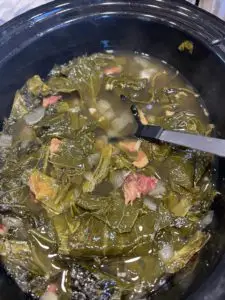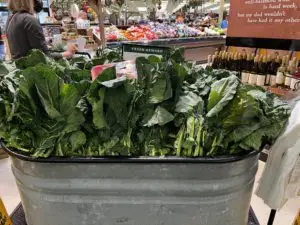
The humble collard green dates back to prehistoric times and is one of the oldest members of the cabbage family and a close relative of kale,

The collard green origins date back to Greece, but the low and slow cooking method that is my favorite originates from the slaves and is still a big part of the soul food menu. Collard Greens was one of the few crops the slaves were allowed to grow to feed themselves and their families.
The pot likker is the highly concentrated broth that comes from cooking the greens over several hours. This likker was the southern grandmother’s answer to the Jewish grandmother’s chicken soup. They claimed it would cure what ails you, and if nothing ails you it would give you a good cleanout.
when shopping for your greens look for ones that have a nice bright color and no yellow leaves. If the are still on the stem they should break from the stem easily.
they are at their best January thru April and love to be kissed by a little frost as this takes some of the bitterness away and makes them a little sweeter
collard greens may lower blood cholesterol, reduce the risk of cancer and improve liver and one health
it’s important to wash your greens well as they do hold onto dirt and sometimes critters. I fill my sink with child water and add some vinegar and salt to it, this will help remove any critters. fully submerge your greens and one by one rinse and set aside. drain your sink and give it a good rinse, fill it back up and clean one more time without the vinegar and salt
collard greens are rich sources of phytonutrients with potent anti-cancer properties, such as Di-indolyl-methane (DIM) and sulforaphane that have proven benefits against prostate, breast, cervical, colon, ovarian cancers by virtue of their cancer-cell growth inhibition and cytotoxic effects on cancer cells.
collard greens contain high levels of vitamin-K, providing a staggering 370% of recommended daily levels per 100 leaves. Vitamin K has a potential role in the increase of bone mass by promoting osteoblastic activity in the bone. It also has a beneficial effect in Alzheimer’s disease patients by limiting neuronal damage in their brain.15
One cup cooked Collard Greens contain
- 63 calories
- 5.15 grames protein
- 7.6 grames fiber
- 5.25 grames protein
- 324 milligrams calcium
- 2.15 milligrams iron
- 40 milligrams magnesium
- 61 milligrams potassium
- 28 milligrams of sodium
- 0.44 milligrams zinc
- 34.6 milligrams vitamin C
- 30 micrograms of vitamin A
- 30 micrograms folate
- 1.67 micrograms vitamin E
- 772.5 micrograms vitamin K
Collard Greens
low and slow-braised collard greens
Servings: 6 to 8
INGREDIENTS
6 small bunches or 3 large bunches around 4-5 pounds collard greens
1 large or two small smoked ham hocks
6 sliced smoked bacon diced
1 medium onion diced
6 cloves garlic chopped
1 tablespoon sugar
2 tsp Worcestershire
1/3 cup apple cider vinegar
several good shakes of Texas Pete pepper sauce plus 3-4 of the peppers
1 teaspoon black pepper
salt to taste
STEPS
1) starting a good 90 minutes until you start your greens rinse your ham hock well and place in a heavy pot or dutch oven and cover with and cook on a slow boil until the meat falls off the bone, anywhere from an hour and a half to two hours
while your ham hocks are cooking wash your green, in a deep sink cover your greens with cold water and rinse well, I add a little vinegar and salt to this first wash as it helps pull out any bugs that might be on the leaves. pull the leaves out and drain the water and rinse your sink out and wash them again.
I prefer to tear my greens away from the stem and then hand tear them. you can also cut them if you like.
cook your bacon and when browned add your onion and cook until tender, add the garlic and cook about one more minute and pour in your crockpot or dutch oven.
then your ham hocks have cooked, pull all that beautiful meat off the bone and chop it and add to the stock pot.
pour the stock in your slow cooker and turn your pot too high.
add the Worcestershire, pepper sauce, peppers, vinegar, pepper, and sugar to the pot.
give this a good stirring and start adding your greens, you will need to do the slowly and let them cook down a bit before adding more.
stir well, cover, and cook stirring occasionally for a good two hours.
at the end taste and add salt if needed, often the bacon and ham hock provide all the salt you need

